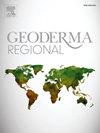Carbon stock, subsurface characteristics and accommodation settings of sub-tropical peatland Histosols, K'gari, Queensland Australia
IF 3.1
2区 农林科学
Q2 SOIL SCIENCE
引用次数: 0
Abstract
Whereas temperate and tropical peatlands have been extensively studied, much less is known about the age, formation history, carbon stock and soil characteristics of subtropical peatlands. Here we investigate the organic carbon density or stock and soil characteristics of three peatlands of K'gari (Fraser Island), Queensland, Australia. The Empodisma minus -dominated peatlands are unique to the subtropics and their bulk density, pH, oxidation-reduction potential, carbon percentages and carbon stocks were compared to other Empodisma sp. peatlands in temperate and montane-alpine climates as well as global peatland estimates. A good agreement occurs between the elemental analyser (LECO) derived carbon percentages and the estimations made by loss-of-ignition-derived carbon percentages using Farmer et al. (2014) conversion factor. Carbon stock estimation ranges between 381.2 and 1665.5 Mg C ha−1 for the total peat depth and ranges between 444.0 and 1189.7 Mg C ha−1 on a per metre basis. The carbon stock average for the Moon Point and Dilli Swamp peatlands is comparable to global peatland estimates with the Red Lagoon peatland is lower than the average. All three peatlands have a higher average carbon stock than other Empodisma-dominated peatlands in temperate and montane-alpine climates.
The three peatland sites chosen are within different morphosequences that range in age between Holocene, 7.8 to 132 ka and 132–263 ka. The Moon Point peatland (Holocene; < 11,700 BP) has a higher bulk density, lower moisture content and higher degree of humification compared to the other morphosequence areas. The difference in peat characteristics is not due to the morphosequence, as the climate changed approximately 6000 to 5000 years BP to be more favourable for peat accumulation across south-east Queensland. However, we suspect the older morphosequence (i.e., Yankee Jack) as well as the Holocene coastal sediment setting, due to their lower topography reduces the groundwater level and the accommodation space for peats to accumulate. The lower accommodation setting limits the peat thickness, increases the number of hiatuses and is susceptible to more peat fires. This study shows the K'gari peatlands are significant carbon sinks and careful management is needed to ensure they do not become carbon emitters as climate continues to change.
澳大利亚昆士兰K'gari亚热带泥炭地组织的碳储量、地下特征和调节环境
温带和热带泥炭地已被广泛研究,但对亚热带泥炭地的年龄、形成历史、碳储量和土壤特征了解甚少。本文研究了澳大利亚昆士兰州K’gari (Fraser Island) 3个泥炭地的有机碳密度或储量及其土壤特征。Empodisma负泥炭地是亚热带特有的泥炭地,其体积密度、pH值、氧化还原电位、碳百分比和碳储量与温带和山地高寒气候下的其他Empodisma泥炭地以及全球泥炭地的估算值进行了比较。元素分析仪(LECO)得出的碳百分比与使用Farmer等人(2014)转换因子得出的失燃碳百分比估算值之间存在良好的一致性。总泥炭深度的碳储量估计在381.2至1665.5 Mg C ha - 1之间,每米的碳储量估计在444.0至1189.7 Mg C ha - 1之间。月点沼泽和迪利沼泽泥炭地的碳储量平均值与全球泥炭地估算值相当,而红泻湖泥炭地的碳储量低于平均值。这三个泥炭地的平均碳储量都高于温带和山地-高山气候中其他以empodisma为主的泥炭地。选取的3个泥炭地遗址在全新世、7.8 ~ 132 ka和132 ~ 263 ka的不同形态序列中。月点泥炭地(全新世;& lt;11,700 BP)与其他形态序列区相比,具有较高的容重、较低的含水率和较高的腐殖化程度。泥炭特征的差异不是由于形态序列,因为大约6000到5000年前的气候变化更有利于整个昆士兰东南部的泥炭积累。然而,我们怀疑更古老的形态序列(如扬基杰克)以及全新世海岸沉积环境,由于其较低的地形降低了地下水位和泥炭沉积的容纳空间。较低的调节设置限制了泥炭的厚度,增加了断裂带的数量,并且容易发生更多的泥炭火灾。这项研究表明,K'gari泥炭地是重要的碳汇,需要仔细管理,以确保它们不会随着气候的持续变化而成为碳排放源。
本文章由计算机程序翻译,如有差异,请以英文原文为准。
求助全文
约1分钟内获得全文
求助全文
来源期刊

Geoderma Regional
Agricultural and Biological Sciences-Soil Science
CiteScore
6.10
自引率
7.30%
发文量
122
审稿时长
76 days
期刊介绍:
Global issues require studies and solutions on national and regional levels. Geoderma Regional focuses on studies that increase understanding and advance our scientific knowledge of soils in all regions of the world. The journal embraces every aspect of soil science and welcomes reviews of regional progress.
 求助内容:
求助内容: 应助结果提醒方式:
应助结果提醒方式:


